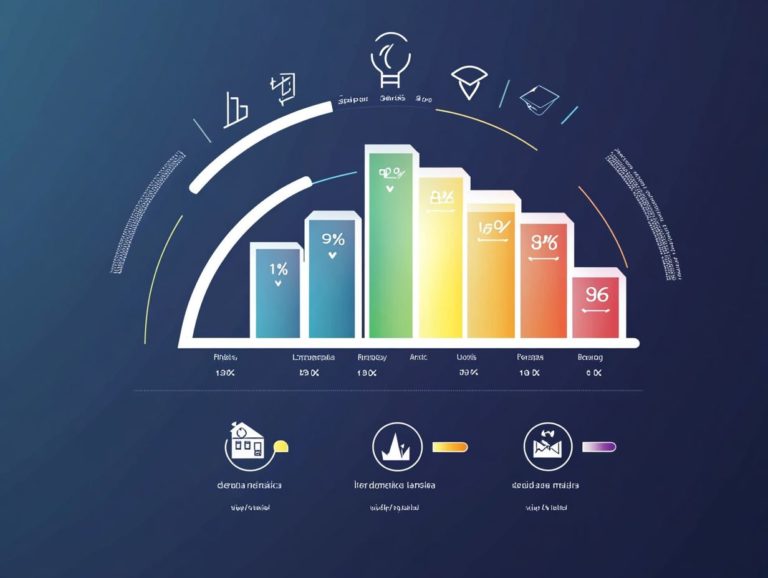The Legal Landscape of Peer-to-Peer Lending
Peer-to-peer (P2P) lending has revolutionized how you approach borrowing and lending money, creating a marketplace connecting borrowers and investors directly.
This article delves into the definition and history of P2P lending, showcasing its benefits for both parties involved. However, it s crucial to weigh the associated risks, such as default rates (the rate at which borrowers fail to repay loans), along with the current regulatory landscape that governs these platforms.
The discussion will also cover the tax implications for participants, offering a comprehensive overview of this cutting-edge financial model.
Contents
- Key Takeaways:
- Overview of Peer-to-Peer Lending
- The Benefits of Peer-to-Peer Lending
- The Risks of Peer-to-Peer Lending
- Regulation of Peer-to-Peer Lending
- Tax Implications of Peer-to-Peer Lending
- Frequently Asked Questions
- What is peer-to-peer lending?
- Is peer-to-peer lending legal?
- What are the laws and regulations governing peer-to-peer lending?
- Do peer-to-peer lending platforms have to comply with any specific regulations?
- What are the potential risks associated with peer-to-peer lending?
- Are there any legal protections for lenders and borrowers in peer-to-peer lending?
Key Takeaways:

Peer-to-Peer Lending is a form of lending that connects borrowers directly with investors, cutting out traditional financial institutions. For borrowers, peer-to-peer lending offers lower interest rates and more flexible terms, while investors can potentially earn higher returns. However, there are risks involved in peer-to-peer lending, such as default rates and lack of regulation.
Overview of Peer-to-Peer Lending
Peer-to-peer (P2P) lending is reshaping the financial landscape, enabling you to secure loans directly from investors through online platforms instead of relying on traditional banks.
This innovative model skyrocketed in popularity after the 2008 financial crisis, meeting urgent borrowing needs by connecting individuals with diverse credit histories to potential funding sources.
P2P lending has transformed the loan application process, offering convenience and a variety of loan types, from personal to business loans.
Platforms like LendingClub, Prosper, FundingCircle, and Upstart have gained traction, allowing you to customize your investment preferences and strategies to fit your unique goals.
Definition and History
Peer-to-peer (P2P) lending is a dynamic approach to direct lending that connects you borrowers with individual investors via online platforms, elegantly sidestepping traditional financial institutions.
This innovative model took off after the 2008 financial crisis, fueled by advancements in financial technology and a growing demand for more accessible borrowing options.
While the roots of P2P lending can be traced back to informal borrowing among friends and family, the concept truly gained momentum in the early 2000s with platforms like Prosper and LendingClub stepping onto the scene.
These platforms offered a streamlined, user-friendly experience that allowed you to assess potential borrowers, set your own interest rates, and diversify your investment portfolio.
In the aftermath of the financial crisis, traditional banks became increasingly risk-averse. This prompted many consumers to explore alternative financing solutions, paving the way for the P2P lending industry to thrive. It delivered not only more flexible credit options but also gave power to you to take control of your financial future, reshaping the lending landscape.
The Benefits of Peer-to-Peer Lending
Peer-to-peer lending offers exciting benefits for both borrowers and investors, establishing itself as a compelling alternative to traditional lending methods.
As a borrower, you’ll find that P2P lending provides remarkable convenience by simplifying the loan application process. It grants you access to funds with potentially lower interest rates and flexible repayment options tailored to your needs.
For investors, this platform opens the door to the prospect of high returns through a diverse array of loan types and investment strategies, all designed to align with your individual preferences.
For Borrowers
For you, peer-to-peer lending offers an accessible and streamlined solution to meet your various borrowing needs, whether personal or business-related. This method boosts financial inclusion. It helps individuals with various credit scores secure loans often denied by traditional banks.
The online application process is typically faster and more convenient, allowing you to access the funds you need without long queues or extensive paperwork.
With flexible repayment options, you can select terms that align with your financial circumstances, helping to minimize stress and promote responsible borrowing.
This innovative approach not only broadens the range of individuals who can qualify for loans but also gives power to you to take control of your financial future in ways that traditional banking often overlooks.
For Investors

Peer-to-peer lending offers a unique chance for impressive returns by directly funding loans to borrowers. You can also spread your investments across different borrowers to lower risk.
This model gives you the power to customize your portfolio according to your personal investment preferences while effectively managing risk.
By utilizing platforms like LendingClub and Prosper, you can explore diverse loan options, each with its own risk profile. This approach allows you to distribute your risk and opens the door to potentially lucrative returns that traditional investment channels may not provide.
You have the flexibility to actively select which loans to fund, aligning your choices with your risk management strategies. Consider essential factors such as borrower credit scores and the purposes of the loans.
This hands-on approach enhances your investment experience and cultivates a deeper connection to your financial aspirations.
The Risks of Peer-to-Peer Lending
Despite the benefits, P2P lending comes with its own set of risks for both borrowers and investors. Key concerns include loan defaults and the creditworthiness of borrower profiles.
Effective risk management is essential for your success. This means taking the time to assess credit histories and evaluate the reliability of borrowers before making any commitments.
Default Rates and Other Risks
One of the primary concerns in P2P lending is the risk of loan defaults, which can significantly affect your returns as an investor. To minimize potential losses, understanding borrower profiles and implementing effective risk management practices is crucial.
By analyzing factors like credit scores, income stability, and previous borrowing behavior, you can gain insights into a borrower s likelihood of defaulting. It’s also important to consider aspects such as employment history and debt-to-income ratios, which provide a more comprehensive view of financial health.
Adopting a diversification strategy can help mitigate risks. By spreading your capital across various loans, you reduce the impact of any single default on your portfolio.
Ultimately, conducting a thorough assessment of both qualitative and quantitative borrower data is vital for making informed investment decisions in this changing market.
Regulation of Peer-to-Peer Lending
The regulation of P2P lending is essential for its smooth operation. It ensures that online platforms and financial institutions follow established guidelines while safeguarding the interests of both borrowers and investors. For those new to this investment approach, understanding peer-to-peer lending can provide valuable insights.
As you navigate the expanding P2P lending landscape, recognize that regulatory oversight is pivotal in upholding the industry’s integrity and long-term sustainability.
Current Legal Landscape
The current legal landscape for P2P lending presents a complex framework of regulations designed to enhance transparency and safeguard consumer interests. For more insights, you can explore the key laws on peer-to-peer lending, as these regulations will influence the industry’s trajectory.
Regulatory bodies like the Securities and Exchange Commission (SEC) and the Financial Industry Regulatory Authority (FINRA) play crucial roles in crafting the guidelines that govern these online lending platforms. For instance, the SEC requires platforms to disclose vital information about borrowers and investment risks, a critical measure for protecting you as an investor.
State-level regulations can vary significantly, impacting how platforms operate across different regions. You stand to benefit from these regulations through enhanced protections that ensure you are well-informed about loan terms.
Meanwhile, investors enjoy increased transparency, giving them the power to make more informed decisions.
Future Outlook and Potential Changes

Looking ahead, the future of peer-to-peer lending is set for transformation. It will be marked by evolving regulations and increased collaboration between online lenders and traditional financial institutions. These developments could enhance consumer trust and open new avenues for P2P lending.
As regulations become clearer, they will greatly impact borrower eligibility and investor confidence. This will foster a more structured and reliable environment. Technology advancements will refine risk assessment models, allowing platforms to match borrowers with the right lenders more effectively. This innovation might attract a wider demographic of users, guiding consumer behavior toward personalized financial solutions.
Both borrowers and investors could enjoy greater returns on investment and improved access to credit, reinforcing the integral role of P2P lending within the broader financial ecosystem.
Tax Implications of Peer-to-Peer Lending
Understanding the tax implications of peer-to-peer lending is crucial, whether you’re borrowing or investing. It directly impacts the financial returns you can expect from these activities.
Familiarizing yourself with reporting requirements and the tax treatment of interest income will help you understand these rules easily, ensuring compliance while maximizing benefits.
Reporting Requirements and Tax Treatment
In peer-to-peer lending, it s essential for both borrowers and investors to understand the reporting requirements and tax implications tied to their transactions. Knowing these details can significantly enhance your returns while ensuring compliance with tax regulations.
As a borrower, keeping track of the total interest you pay is vital. This amount may be tax-deductible, especially if it pertains to a home purchase loan.
If you re an investor, you must report your interest income as ordinary income on your tax returns. Diligent record-keeping of all transactions is necessary.
For example, if you fund multiple loans through a platform, expect to receive a Form 1099-INT, which outlines the total interest you’ve earned for the year. Staying organized is important, as tax obligations can fluctuate based on individual circumstances and the type of income generated in the P2P lending landscape.
Frequently Asked Questions
What is peer-to-peer lending?
Peer-to-peer lending is a way for individuals to lend money directly to other individuals or businesses, without going through a traditional financial institution.
Is peer-to-peer lending legal?

Yes, peer-to-peer lending is legal in most countries. However, laws and regulations may vary, so make sure to research the legal landscape of peer-to-peer lending in your specific location.
What are the laws and regulations governing peer-to-peer lending?
The laws and regulations governing peer-to-peer lending vary by country. They typically include consumer protection laws, lending regulations, and securities laws. To understand the evolving landscape, it’s essential for both lenders and borrowers to familiarize themselves with what is the future of peer-to-peer lending before participating.
Do peer-to-peer lending platforms have to comply with any specific regulations?
Yes, many countries have specific regulations for peer-to-peer lending platforms. These regulations may include requirements for registration, licensing, and understanding the peer-to-peer lending process for disclosure of information to investors and borrowers. Compliance is crucial for maintaining transparency and protecting users.
What are the potential risks associated with peer-to-peer lending?
As with any form of lending, peer-to-peer lending involves inherent risks. These include borrower default, fraud, and platform bankruptcy. Individuals should carefully research and diversify their investments on these platforms to minimize risks.
Are there any legal protections for lenders and borrowers in peer-to-peer lending?
Yes, there are legal protections for both lenders and borrowers in peer-to-peer lending, depending on the country, and understanding the market trends in peer-to-peer lending can help navigate these regulations effectively.
These protections can include ways to solve problems, enforce contracts, and set rules for loan terms and interest rates.
Before you dive into peer-to-peer lending, get to know your protections! They can save you from potential issues.






